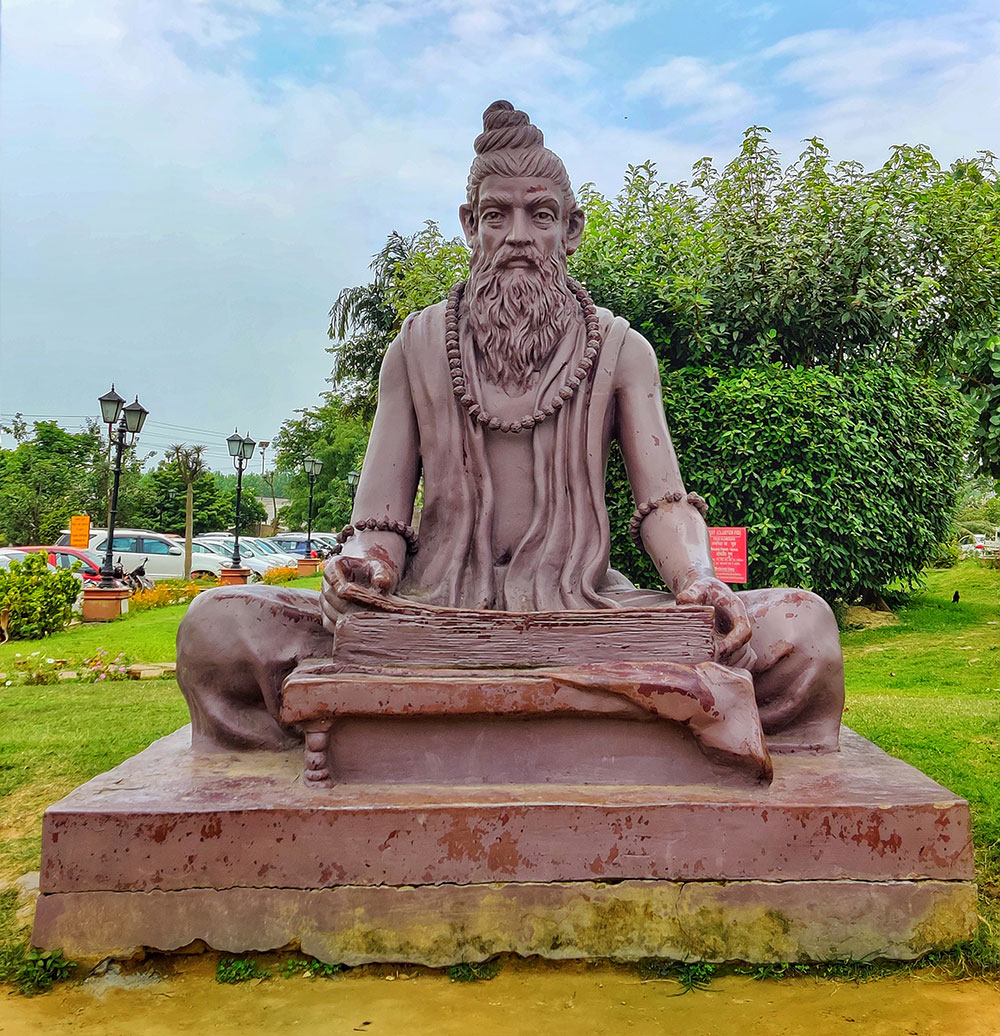
Susan views the world through a lens of spirituality, health,…
More yoga practitioners are beginning to understand that the asanas, or physical practice of yoga, is only a small part of what yoga really is. To truly reap the benefits of yoga, you must practice all eight branches as laid out in the Yoga Sutras written down by the mythic sage, Patanjali.
Patanjali was not the author of the yoga sutras, but his is the written record of these ancient teachings that survived through time. Patanjali’s yoga sutras are a series of verses divided into four chapters. They form the moral and philosophical foundation for many of today’s modern postural yoga classes.
One of the important, yet often overlooked, yogic teachings are the tapas. These are the third part of the branch of yoga called the niyamas. Through the tapas you maintain the willpower to stay on the yogic path.
From the Yoga Sutras to applying tapas on and off the mat in your daily asana and yoga practice, read on to see how this discipline of fire can apply to your personal spiritual journey.
Patanjali’s Yoga Sutras and Tapas

The sage, Patanjali, is sometimes referred to as the father of Yoga. He has been elevated to mythical status because of the importance of the text he left the world.
His verses, or yoga sutras, form the basis for the modern practice of yoga. Chapter two of this text concerns Sadhana Pada — of the path of practice. In this chapter, Patanjali described Ashtanga Yoga, or the eight limbs of yoga.
- Yama
- Niyama
- Asana
- Pranayama
- Pratyahara
- Dharana
- Dhyana
- Samadhi
All eight branches are meant to support each other, not progressively, but as a whole in whichever order a yoga practitioner happens to approach them — although some will naturally arrive first before others.
Tapas are part of the second branch, the Niyamas. But they were already described by Patanjali in before the eight limbs when he describes Kriya Yoga, or the yoga of action.
Tapas are so important that they are mentioned when Patanjali described the physical practice of yoga. Tapas, in Kriya Yoga, is to have endurance and acceptance.
2.1: tapah svadhyaya ishvarapranidhana kriya yogah
Yoga practice requires willfully exposing oneself to the metaphorical element of fire within one’s practice, serious study, and aligning your actions with the true self.
The other two parts of Kriya Yoga are Swadhyaaya, or self-awareness and self-study, and Ishwara Pranidhaana, or devotion to and love for the divine.
Overview of the Yamas and Niyamas of Ashtanga Yoga

When going deep into the yoga of action, it helps to observe the rules and disciplines to help with the practice. This is what the first two limbs, the Yamas and Niyamas of yoga are about.
The Yamas are also called the five restraints. They are rules of what to avoid when embarking on a spiritual path. The Yamas are a code of ethics and morality for yogis to follow.
- Ahimsa – non-violence
- Satya – truthfulness
- Asteya – non-stealing
- Brahmacharya – chastity
- Aparigraha – non-possessiveness
The Niyamas are the second limb of Ashtanga in the Yoga Sutras. They are things you must do to lead a spiritual and pure life.
- Saucha – cleanliness or purity of the body
- Santosha – happiness and contentment
- Tapas – endurance and acceptance
- Svadhyaya – self-awareness, and self-study
- Ishwara Pranidhaana – Devotion to and love for the divine
Notice that the last three niyamas are the parts that describe Kriya Yoga.
Tapas – The Third Niyama of Discipline

Tapas are the way to purify your yoga practice through discipline. They can also be translated as the “internal fire” which burns away your impurities and spark the divinity to awaken within you.
But even though the Tapas encourage you to burn with an internal fire for the discipline of yoga, it does not mean you push yourself towards a heated practice on the mat every time you practice asana.
The Tapas are an internal wisdom that urges you to stick to your practice even when you just don’t feel like it, or you feel like giving up. Remembering the discipline of the tapas will help reignite your fire and enthusiasm for yoga and keeping to your spiritual path.
The Three Types of Tapas

Some tapas can aid your spiritual journey while some are considered demonic and can hold you back. Patanjali described three types of tapas in the Yoga Sutras.
Rajasic Tapas
Rajasic Tapas are those of people who do everything with the motive of getting something back or achieving something. These types of people show off when they are suffering for their spiritual practice.
They make a great show of looking tired and hungry when they are fasting and they proclaim at every opportunity how everyone must be like them when they meditate for days, or only vegan food, or walk barefoot in the snow for miles as part of their sadhana.
Rajastic Tapas are all about the “I” and do not contribute to a healthy spiritual life.
Tamasic Tapas
Tamasic Tapas are held by people who cannot torture others, therefore they torture themselves. In the name of spiritual discipline, they will self-flagellate, walk on fire, hammer nails into their body, or fast for months.
This type of tapas is practiced due to ignorance and self-denial. They are described as demonic tapas because they cause you to abuse yourself and agitate others.
Sattvic Tapas
Sattvic Tapas are the ideal tapas. They do not require you to do anything. They burn within you because you are part of the waves and current. Just like the ocean, waves will always rise and fall in your life and within your spiritual practice. But these waves do not affect you.
You acknowledge that these rises and falls come and go and you have no control over them. And that is how you live with fire in your life as a spiritual practitioner. Nothing to gain, nothing to suffer from. Just burning with enthusiasm, endurance, and acceptance.
There are even three deeper parts of Sattvic Tapas which concern your entire being.
- Bodily Tapas – these concern physical hygiene, staying active and alert, and keeping lethargy away.These tapas discipline your senses. For example, you do not eat gluttonously. You eat when you need to eat to nourish your body. You do not indulge in sweets because your tongue craves the sugar. You have power over your senses.
- Tapas of Speech – these are all about speaking the truth and speaking with pleasantness.It is not about speaking the truth for truth’s sake if it will hurt or insult others. Tapas of speech discipline you to control what you say and how you say it. Even when the truth may be difficult to hear, you have control over how to speak with compassion and in a way that calms and quiets the mind of those who listen to you.
- Tapas of Mind – these tapas discipline you to keep a close observance over your pleasure-seeking mind.
- When you are able to voluntarily relinquish pleasures that distract and fill your mind, you begin to discipline your mind for long-lasting fulfillment rather than the temporary high that sense pleasures bring.
Tapas in Modern Yoga

Some modern yoga definitions of tapas mistakenly only focus on the fire and discipline aspect of this deep spiritual topic. But the tapas are a complete body, mind, and spiritual discipline for leading a spiritual life.
They are not merely about a yoga practice that builds fire or heat in your body through core-activating asana and dynamic vinyasa sequences.
Your Tapas

Tapas are not meant to only be practiced on your yoga mat but throughout your whole life. Your tapas can be as personal and meaningful for your spiritual practice and path as you need them to be.
If you have a yoga asana practice, your tapas can be your dedication to get on your mat every single morning to practice asana and meditation.
Or your tapas may be a discipline to fast for one day a week or three days a month for your spiritual sadhana.
As Swami Satchidananda, the Woodstock Guru of the hippies said, “tapas is self-discipline, not self-torture. It is right effort, not more effort.”
Tapas are your personal discipline to practice yoga and spirituality with no other intention than to reach your own highest potential, just like Patanjali wrote in the Yoga Sutras.
2.32: saucha santosha tapah svadhyaya ishvarapranidhana niyama
Cultivate purity of mind, an attitude of contentment, the difficult practice of beneficial change, study of the self, and alignment of actions with the true self.
How to Practice with Burning Enthusiasm

To practice yoga with the discipline of the tapas helps you to remember that life is an unknown road. Parts will be bumpy and other parts will be smooth and enjoyable.
You cannot control what comes your way but you can control how you accept them. Through your personal discipline and practicing with tapas. They help you to push further even when you feel tired or like giving up.
The last time the tapas are mentioned in the Yoga Sutras, Patanjali wrote how willfully exposing yourself to the element of fire will purify you.
2.43: kaya indriya siddhih ashuddhi kshayat tapasah
Willfully exposing oneself to the metaphorical element of fire within one’s practice brings complete attainment of bodily power and completely removes impurities therein.
This metaphorical fire is what will sustain your burning enthusiasm and passion to practice the spiritual discipline that is yoga.
For many, keeping this fire alive means practicing asana rigorously. For others, the fire burns just as bright with a discipline of sitting in silent meditation every day.
Conclusion

When you apply the tapas into your yoga practice, you will be able to deepen your experience of yoga beyond merely the physical asana.
Your yoga asana practice can help you access the internal fire of the tapas, but ultimately, it is your willpower, passion, discipline, and internal flame that will keep you going.
But beware of unhealthy tapas that will hinder your spiritual growth. Tapas which are practiced for recognition or through self-denial and toruture are negative flames that should be snuffed out.
Tapas are a discipline of understanding the ebb and flow of life and being part of it.
When you are dedicated to making yoga a lifelong commitment beyond temporary pleasures, the true gifts of the tapas will bear fruit for your body, mind, and spirit.
What's Your Reaction?
Susan views the world through a lens of spirituality, health, and compassion. Her positive outlook on life shines through her writing, which is heavily focused on yogic living, meditation, and conscious eating.














